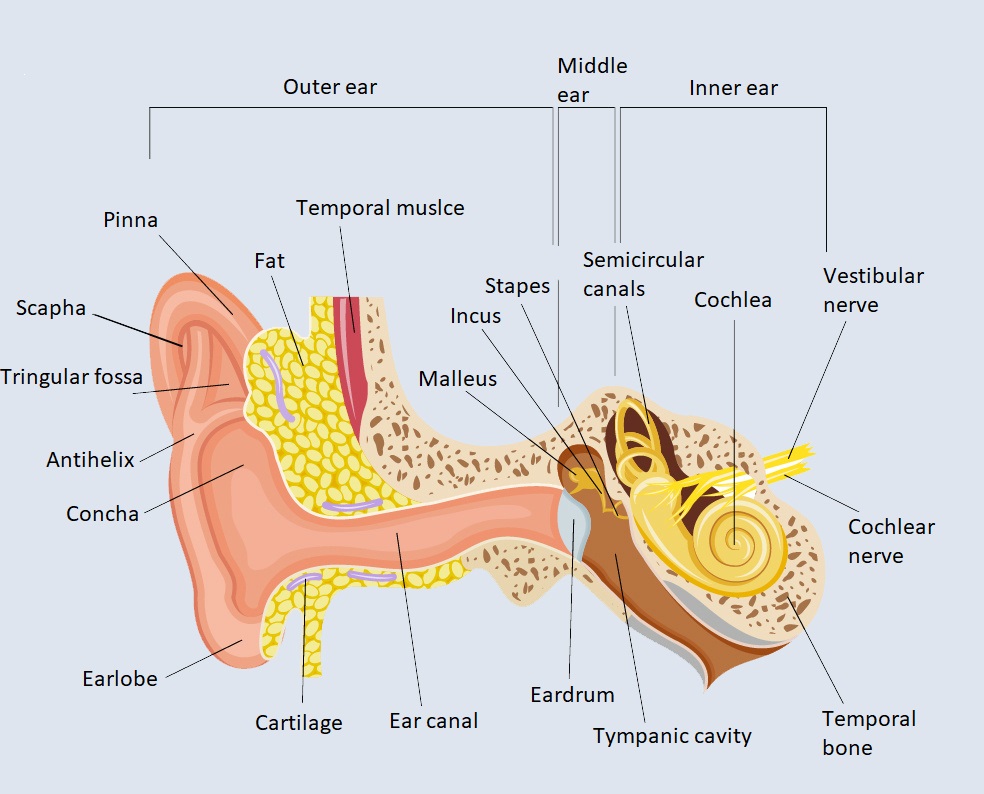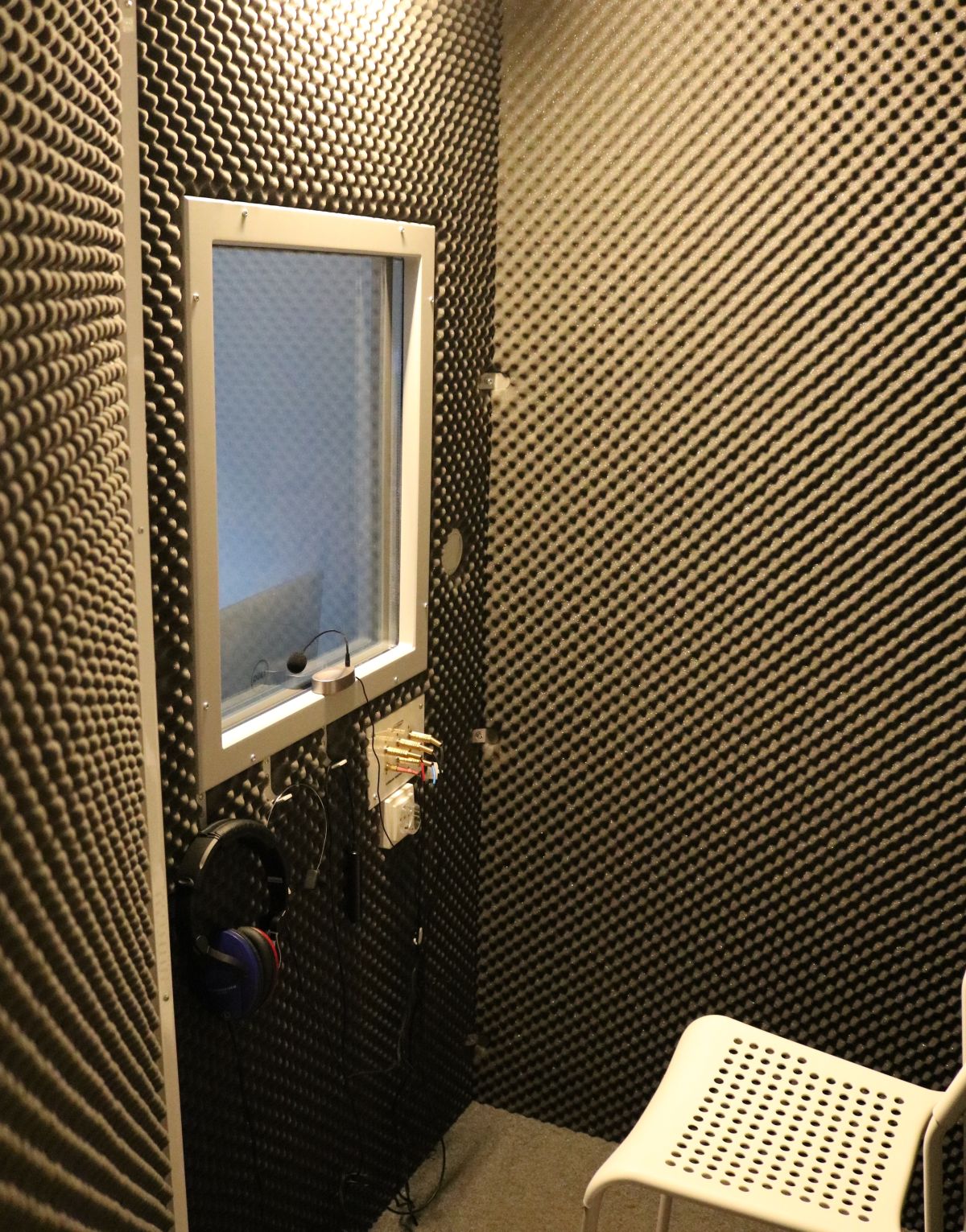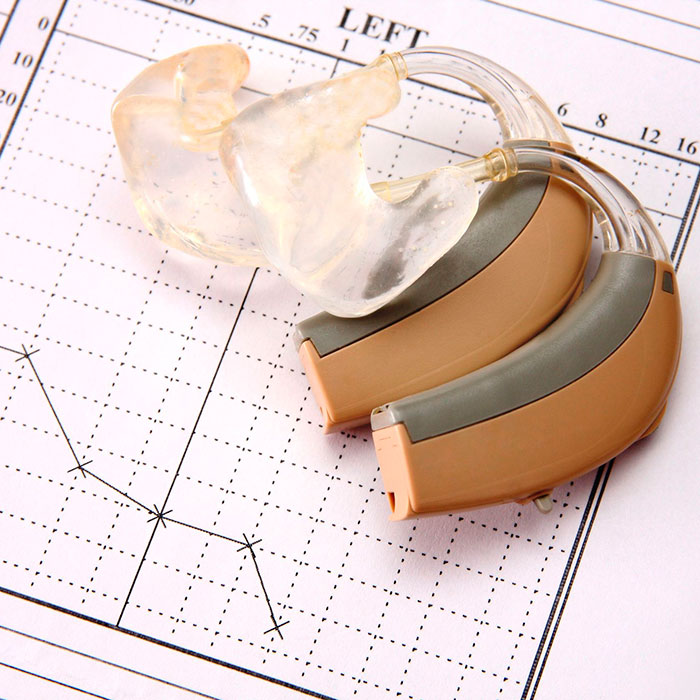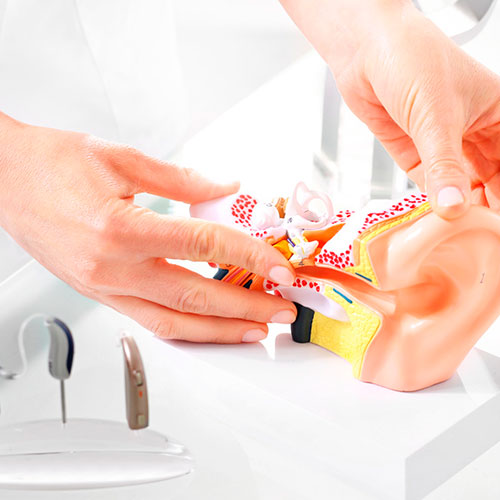Audiology
What does audiology deal with?
Audiology is the field of otolaryngology that deals with the diagnosis and screening of hearing loss. The audiological examination is performed by an audiologist to determine the type of hearing impairment and to determine the extent of hearing loss.

How is the ear made up?
Our ears are an integral part of the system of hearing and balance. The function of the auditory system is to capture the acoustic stimuli of the outside world and then transform and transmit them to the auditory centre of the brain using the central processing system. The system of balancing registers the position and movements of the head and informs the somatic motor system about these, which controls the movement of skeletal muscles.
The ear can be divided into three parts: outer, middle, and inner ear. The outer ear includes the concha, the external ear canal, and the earlobe, which is separated from the middle ear by the eardrum. In the middle ear are the auditory ossicles (malleus, incus, stapes), which are responsible for transmitting air vibrations to the cochlea. The vibrations in the organ of Corti in the cochlea filled with fluid are converted into stimuli, which are transmitted by the auditory nerve to the auditory centre of the brain.
In terms of functioning, we distinguish between a sound transmitting and a sound receiving system. The sound transmitting system includes the concha, ear canal, eardrum, auditory ossicles and labyrinth fluids, and the section from the stimulus-receiving hair cells of the organ of Corti to the cerebral cortex, belongs to the sound-receiving apparatus
How will sound become perception?
Hearing is the perception and conscious processing of sound-frequency air vibrations, that is, sounds. The air vibrations must reach the fluid in the cochlea in the inner ear to stimulate the hair cells in the cochlea. These hair cells are located in four rows on the organ of Corti, along the cochlea.
Sound vibrations are transmitted to the inner ear through the external ear canal and the middle ear. The concha allows sound to pass through the external ear canal to the eardrum. The function of the middle ear is to convert the sound vibrations that come here and transmit them to the inner ear. In the inner ear, frequency analysis, the breakdown of complex sound vibrations into components and their conversion into stimuli takes place, which the auditory nerve can carry on to the cerebral cortex.
What can cause hearing loss?
If there is a disturbance anywhere in the process of hearing described above, we speak of hearing loss. Hearing ability usually decreases with age, but contrary to misconceptions, hearing loss is not only common among the elderly. Anyone can experience hearing loss at a young age (significant background noise, loud music, noise at work, sudden sound effects) but it can also be caused by a congenital problem.
Hearing loss can be caused by damage to the sound transmitting system or the absence or the absence of sensory cells, or the combination of both.
In case of damage to the sound transmitting system, the external ear canal, the eardrum, or the middle ear, we can speak of transmissive hearing loss. Typically, hearing is reduced considering a frequency, which can be triggered by an ear infection, an enlarged tonsil in children, or even an accumulation of earwax. A common cause in adults is otosclerosis. As a result of the disease, spongy material is deposited and solidified, as a result of which the movement of the stapes becomes impossible, it does not transmit sound properly, which causes a gradual unilateral hearing loss or bilateral hearing loss. Transmissive hearing loss is usually mild to moderate but can be temporary.
Nerve-related hearing loss is caused by the malfunction or lack of sensory cells. This includes hearing loss due to age, noise, or the destruction of the cochlea or auditory nerves as a side effect of certain medicines (aspirin). This type of hearing loss is usually permanent.

It is worth noting that untreated high blood pressure and diabetes can increase the risk of developing hearing loss.

With what symptoms should we visit an audiology clinic?
If we notice any change in our hearing, it is first recommended to visit an otolaryngology clinic with the complaint so that the underlying causes, inflammation, and possible organ changes can be determined.
An otolaryngologist referral is required for an audiology appointment.
It is worth visiting an audiology clinic in case of the following complaints:
- Tinnitus, ringing in the ears
- Hearing and speech problems
- Dizziness
- Balance disorder
How can hearing loss be examined?
Hearing problems can be examined with various methods. There are objective procedures that do not require the active participation of the patient, as well as subjective measurements where we can obtain the test results with the active participation of the patient.
Depending on the complaints, the audiologist can perform the following examinations at our clinic:
Tuning fork test
The essence of this subjective examination method is to determine whether the hearing problem is caused by damage to the sound transmitting system, and after performing the examination, we can also deduce the extent of the dysfunction. The audiologist places the plucked fork in the centre of the subject’s forehead or top of the head, and then compares the feeling of loudness in front of and behind the ear based on the patient’s feedback.
Hearing range test
A subjective hearing test method that can be used to determine the least intense sound that a patient hears.
The test is performed in a soundproof room called a quiet chamber. During the examination, the patient must provide feedback to the audiologist performing the examination on the perception of vibrations coming through a device placed in the bony area behind the ear and on clear sounds in the earphones.
On the two ears, the air transmitting hearing range and the bone transmitting hearing range are determined separately, from which a so-called audiogram is made. This will give you an accurate picture of the extent of your hearing loss.


Speech audiometry
The test, similar to the hearing range one, often takes place afterwards. We perform two types of tests, one is the speech-hearing range and the other is the speech comprehension test. In a soundproof room, phonetically balanced, one-syllable words and phrases heard from the earpiece should be indicated by the patient in the first phase of the study, if detected, and then repeated after hearing in the next phase of the study. Speech is considered comprehensive to the patient perceives or recites at least 50% of the given speech.
Middle ear analysis (tympanometry)
Middle ear analysis measures the pressure in the middle ear to detect whether there is fluid in the ear, a perforation in the eardrum, and to assess the extent of hearing loss through reflex muscle function (a contraction of the stapedius muscle hearing a strong voice). During the test, the ear canal is closed with a special device and the internal pressure is raised and then reduced. The elasticity of the eardrum is measured using a sound generator and a microphone. During the test, the subject will not hear a very strong but loud voice.
Tinnitometry
It is used to test for tinnitus. In the first step, subjective hearing tests (hearing range audiometry, speech audiometry) are required, followed by an examination of tinnitus. During the test, the frequency and volume of the tinnitus are determined with an audiometer, and it is measured what sound makes the tinnitus disappear or temporarily subside.
What happens during the audiological examination?
The course of the audiological examination may differ depending on the complaints, as different examinations may be justified. Before the examination, the audiologist records the medical history: they interview the patient about the nature of the complaint, previous and family illnesses. The audiologist then examines the outer ear, ear canal, eardrum, and then performs the necessary examinations based on the medical indication. They give the patient detailed information about the results of the tests and explains the most effective treatment.
What are the treatment options?
Once the type and extent of hearing loss has been determined, the audiologist will recommend appropriate treatment and hearing aid type.
Transmissive hearing loss can be treated with medication or surgery in mild to moderate cases. It can also be treated with a hearing aid, a middle ear implant or a bone transmitting implant.
A hearing aid or middle ear implant may be a solution for nerve-related hearing loss. In severe cases, implantation of a cochlear implant can remedy the problem.
